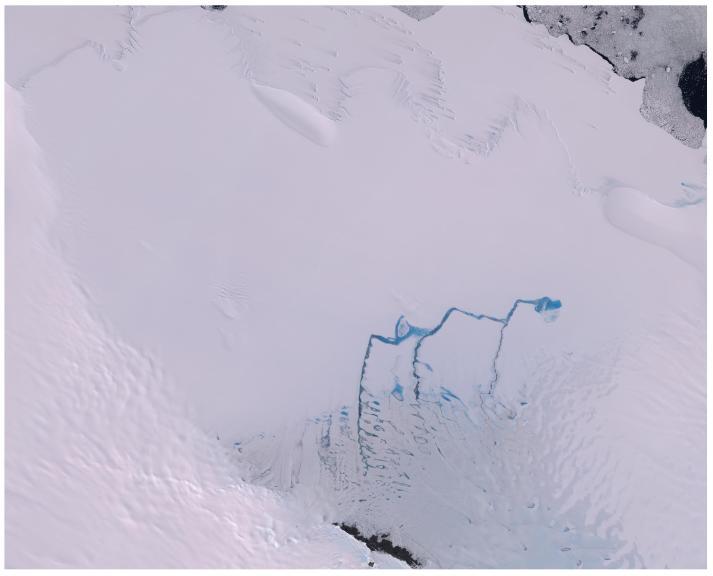
Lead supervisor: Rebecca Dell, Scott Polar Research Institute
Co-supervisor: Neil Arnold, Scott Polar Research Institute
Brief summary:
This project will use state-of-the-art remote sensing and machine learning techniques to produce a continent-wide 3D dataset of surface and shallow sub-surface meltwater on Antarctic ice shelves, before routing this meltwater across potential flow pathways. Image reference: Meltwater systems on the Nivlisen Ice Shelf in January 2020. Contains modified Copernicus Sentinel data (2020), processed by Dr Rebecca Dell.
Importance of the area of research concerned:
Approximately 75% of Antarctica’s coastline is bordered by ice shelves, floating extensions of the grounded ice that act to buffer the continent’s contributions to global sea levels. These ice shelves are extremely vulnerable to climate warming, as they undergo surface melting and basal melting at the ice-atmosphere and ice-ocean interfaces. Studies on the stability of Antarctica’s ice shelves under present day and future climate scenarios, therefore, have never been more crucial. Both surface and shallow sub-surface meltwater can drive ice-shelf instability through firn-air depletion, ponding, flexure and hydrofracture, and surface meltwater also has implications for the melt-albedo feedback. Whilst recent research has produced datasets of surface meltwater occurrence across all Antarctic ice shelves, our current understanding of meltwater storage at the sub-surface, surface to sub-surface hydrological connections, and lateral routing of this meltwater across ice-shelf (sub)surfaces, is lacking. This project aims to advance our current understanding of surface and sub-surface meltwater systems across Antarctica’s ice shelves using remote sensing and machine learning.
Project summary :
First, the student will produce the first seasonal 3D maps of surface and sub-surface meltwater extent across Antarctica’s ice shelves, and the areas immediately above the grounding line of these ice shelves. To do this, they will produce new datasets, and adapt / combine existing datasets on (i) surface meltwater extent, (ii) sub-surface meltwater extent, (iii) firn depth and density, (iv) winter accumulation depth, and (v) blue ice extent into a 3D grid. This will advance our understanding of the available accommodation space for meltwater storage across each ice shelf, and how it varies through time. Second, the lateral routing pathways for meltwater will be investigated. This will allow us to identify ice shelves prone to localised meltwater ponding (which may drive hydrofracture) vs. ice shelves that are prone to surface meltwater run-off through surface river systems.
What will the student do?:
To achieve the overall aims as described in the project summary, the student will do the following:
- Develop a machine learning approach within Google Earth Engine that exploits Sentinel-1 imagery and, where available, existing airborne and field radar data to map the extent of sub-surface meltwater.
- Validate this machine learning approach over a set of example ice shelves, before applying it across all Antarctic ice shelves.
- Combine this novel sub-surface meltwater dataset with pre-existing datasets on (i) surface meltwater extent, (ii) firn depth and density, (iii) winter accumulation depth, and (iv) blue ice extent, to produce a 3D grid of present day (sub)surface meltwater extent and storage capacities.
- Model potential lateral flow routing pathways across the ice shelves using the Reference Elevation Model of Antarctica (REMA) DEM.
References - references should provide further reading about the project:
Arthur, J.F., Stokes, C., Jamieson, S.S., Carr, J.R. and Leeson, A.A., 2020. Recent understanding of Antarctic supraglacial lakes using satellite remote sensing. Progress in Physical Geography: Earth and Environment, 44(6), pp.837-869.
Dell, R.L., Banwell, A.F., Willis, I.C., Arnold, N.S., Halberstadt, A.R.W., Chudley, T.R. and Pritchard, H.D., 2022. Supervised classification of slush and ponded water on Antarctic ice shelves using Landsat 8 imagery. Journal of Glaciology, 68(268), pp.401-414.
Dunmire, D., Banwell, A.F., Wever, N., Lenaerts, J. and Datta, R.T., 2021. Contrasting regional variability of buried meltwater extent over 2 years across the Greenland Ice Sheet. The Cryosphere, 15(6), pp.2983-3005.
Applying
You can find out about applying for this project on the Scott Polar Research Institute page.